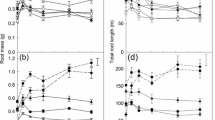Abstract
We compared root proliferation in fertilized microsites among seven cultivars of five commonly planted cool-desert perennial grass species that differ in productivity and competitive ability. In a greenhouse experiment on nutrient-limited plants, one soil microsite in each pot received distilled water (control) and a second microsite received a rich, complete nutrient solution (fertilized). Roots in and adjacent to the microsites were mapped on Mylar windows for 22 days after the injections to determine the magnitude and timing of response in root length relative growth rates (RGRs). Because we provided adequate water, used a high level of fertilization in the treatment microsites, and conducted the experiments during rapid vegetative growth, the results provide a measure of the relative capacities and maximal rates of the grasses responses to enriched microsites. Root samples were harvested from control and fertilized microsites at the end of the experiment to determine the morphological basis of the proliferation response. In all seven grasses fine roots proliferated in the fertilized microsites faster than in the control microsites. The grasses did not differ in the timing of their response which showed a peak 7–8 days after injection. Although one species, Pseudoroegneria spicata cv. Goldar, had higher maximum root length RGR and higher RGR ratio (RGR in fertilized to RGR in control microsites) 7–8 days after injection, the seven grasses did not differ significantly in the magnitude of root length RGR response to fertilizer integrated over the 22 day experiment. The grasses also did not differ significantly in root morphological changes in fertilized mocrosites. Compared to roots in control microsites, roots in fertilized microsites had greater specific root length, length of secondary roots per length of main axis, number of lateral and sublateral roots per length of main axis, and mean lateral root length. Root proliferation was mainly the result of increased lateral branching and lateral root growth in all seven grasses. The consistency of root proliferation responses among these seven cultivars suggests that differences in the capacity for, maximum rate, or morphological basis of root proliferation are not directly related to ecological characteristics such as productivity and competitive ability. Other aspects of root response to nutrient enrichment, such as differential responses as a function of microsite nutrient concentration, plant phenology, plant nutrient status, or specific nutrient element(s), may still be important, but further experiments are required to determine whether different responses to enriched soil microsites among species correspond with know species differences in ecological characteristics.
Similar content being viewed by others
References
Asay KH, Knowles RP (1985) The wheatgrasses. In: Barnes RF, Metcalfe DS, Heath ME (eds) Forages: the science of grassland agriculture. Iowa State University Press, Ames, pp 166–176
Asay KH, Dewey DR, Gomm FB, Johnson DA, Carlson JR (1985a) Registration of ‘Hycrest’ crested wheatgrass. Crop Sci 25:368–369
Asay KH, Dewey DR, Gomm FB, Johnson DA, Carlson JR (1985b) Registration of ‘Bozoisky-Select’ Russian wildrye. Crop Sci 25:575–576
Asay KH, Dewey DR, Gomm FB, Horton WH, Jensen KB (1986) Genetic progress through hybridization of induced and natural tetraploids in crested wheatgrass. J Range Manage 39:261–263
Bavel CHM van, Lascano R, Wilson DR (1978) Water relations of fritted clay. Soil Sci Soc Am 42:657–659
Black RA, Richards JH, Manwaring JH (1994) Nutrient uptake from enriched soil microsites by three Great Basin perennials. Ecology 75:110–122
Brown DP, Pratum TK, Bledsoe C, Ford ED, Cothern JS, Perry D (1991) Noninvasive studies of conifer roots: nuclear magnetic resonance (NMR) imaging of douglas-fir seedlings. Can J For Res 21:1559–1566
Caldwell MM, Richards JH (1986) Competing root systems: morphology and models of absorption. In: Givnish TJ (ed) On the economy of plant form and function Cambridge University Press Cambridge, pp 251–273
Caldwell MM, Richards JH, Johnson DA, Nowak RS, Dzurec RS (1981) Co** with herbivory: Photosynthetic capacity and resource allocation in two semiarid Agropyron bunchgrasses. Oecologia 50:14–24
Caldwell MM, Eissenstat DM, Richards JH, Allen MF (1985) Competition for phosphorus: differential uptake from dual-iso-tope-labeled soil interspaces between shrub and grass. Science 229:384–386
Caldwell MM, Manwaring JH, Jackson RB (1991a) Exploitation of phosphate from fertile soil microsites by three Great Basin perennials when in competition. Funct Ecol 5:757–764
Caldwell MM, Manwaring JH, Durham SL (1991b) The microscale distribution of neighbouring plant roots in fertile soil microsites. Funct Ecol 5:765–772
Caldwell MM, Dudley LM, Lilieholm B (1992) Soil solution phosphate, root uptake kinetics and nutrient acquisition: implications for a patchy soil environment. Oecologia 89:305–309
Campbell BD, Grime JP (1989) A comparative study of plant responsiveness to the duration of episodes of mineral nutrient enrichment. New Phytol 112:261–267
Chapin FS III (1980) The mineral nutrition of wild plants. Annu Rev Ecol Syst 11:233–260
Chapin FS III (1988) Ecological aspects of plant mineral nutrition. Adv Plant Nutr 3:161–189
Christie EK, Moorby J (1975) Physiological responses of semiarid grasses. I. The influence of phosphorus supply on growth and phosphorus absorption. Aust J Agric Res 26:423–436
Crick JC, Grime JP (1987) Morphological plasticity and mineral nutrient capture in two herbaceous species of contrasted ecology. New Phytol 107:403–414
Currie PO, White RS (1982) Drought survival of selected forage grasses commonly seeded in the Northern Great Plains. Can J Plant Sci 62:949–955
Drew MC (1975) Comparison of the effects of a localized supply of phosphate, nitrate, ammonium and potassium on the growth of the seminal root system, and the shoot, in barley. New Phytol 75:479–490
Eissenstat DM (1991) On the relationship between specific root length and the rate of root proliferation: a field study using citrus rootstocks. New Phytol 118:63–68
Eissenstat DM (1992) Costs and benefits of constructing roots of small diameter J Plant Nutr 15:763–782
Eissenstat DM, Caldwell MM (1988a) Competitive ability is linked to rates of water extraction: a field study of two aridland tussock grasses. Oecologia 75:1–7
Eissenstat DM, Caldwell MM (1988b) Seasonal timing of root growth in favorable microsites. Ecology 69:870–873
Epstein E (1972) Mineral nutrition of plants: principles and perspectives. Wiley, New York
Friend AL, Eide MR, Hinckley TM (1990) Nitrogen stress alters root proliferation in Douglas fir seedlings. Can J For Res 20:1524–1529
Granato TC, Raper CD Jr (1989) Proliferation of maize (Zea mays L.) roots in response to localized supply of nitrate. J Exp Bot 40:263–275
Grime JP (1979) Plant strategies and vegetation processes. John Wiley, Chichester
Grime JP, Crick JC, Rincon JE (1986) The ecological significance of plasticity. In: Jennings DH, Trewavas AJ (eds) Plasticity in plants. Cambridge University Press, Cambridge, pp 5–29
Gurevitch J, Chester ST Jr (1986) Analysis of repeated measures experiments. Ecology 67:251–255
Haferkamp MR, Currie PO, Volesky JD Knapp BW (1992) Mortality of crested wheatgrass and Russian wildrye during drought. J Range Manage 45:355–357
Harris GA, Wilson AM (1970) Competition for moisture among seedlings of annual and perennial grasses as influenced by root elongation at low temperature. Ecology 51:530–534
Jackson RB, Caldwell MM (1989) The timing and degree of root proliferation in fertile-soil microsites for three cold-desert perennials. Oecologia 81:149–153
Jackson RB, Caldwell MM (1991) Kinetic responses of Pseudorogneria roots to localized soil enrichment. Plant Soil 138:231–238
Jackson RB, Caldwell MM (1992) Shading and the capture of localized soil nutrients: nutrient contents, carbohydrates, and root uptake kinetics of a perennial tussock grass. Oecologia 91:457–462
Jackson RB, Manwaring JH, Caldwell MM (1990) Rapid physiological adjustment of roots to localized soil enrichment. Nature 344:58–60
Kovar JL, Barber SA (1989) Reasons for differences among soils in placement of phosphorus for maximum predicted uptake. Soil Sci Soc Am J 53:1733–1736
Looman J, Heinrichs DH (1973) Stability of crested wheatgrass pastures under long-term pasture use. Can J Plant Sci 53:501–506
Miller RF, Seufert JM, Haferkamp MR (1987) The ecology and management of bluebunch wheatgrass (Agropyron spicatum): a review (Agric Exp Sta Bull 669). Oregon State University, Corvallis
Murray RB (1984) Yields, nutrient quality and palatability to sheep of fourteen grass accessions for potential use on sagebrush-grass range of southeastern Idaho J Range Manage 37:343–348
Nye PH (1977) The rate-limiting step in plant nutrient absoorption from soil. Soil Sci 123:292–297
Passioura JB, Wetselaar R (1972) Consequences of banding nitrogen fertilizers in soil. II. Effects on the grwoth of wheat roots. Plant Soil 36:461–473
Pyke DA (1990) Comparative demography of co-occuring introduced and native tussock grasses: persistence and potential expansion. Oecologia 82:537–543
Richards JH, Caldwell MM (1985) Soluble carbohydrates, concurrent photosynthesis and efficiency in regrowth following defoliation: A field study with two Agropyron species. J Appl Ecol 22:907–920
SAS Institute (1987) Box 8000 Cary, North Carolina 27511, USA
Silberbush M, Barber SA (1983) Sensitivity of simulated phosphorus uptake to parameters used by a mechanistic-mathematical model. Plant Soil 74:94–100
Smoliak S, Johnston A (1980) Russian wildrye lengthens the grazing season. Rangelands 2:249–250
Smoliak S, Dormaar JF (1985) Productivity of Russian wildrye and crested wheatgrass and their effect on prairie soil J Range Manage 38:403–405
Author information
Authors and Affiliations
Rights and permissions
About this article
Cite this article
Larigauderie, A., Richards, J.H. Root proliferation characteristics of seven perennial arid-land grasses in nutrient-enriched microsites. Oecologia 99, 102–111 (1994). https://doi.org/10.1007/BF00317089
Received:
Accepted:
Issue Date:
DOI: https://doi.org/10.1007/BF00317089




